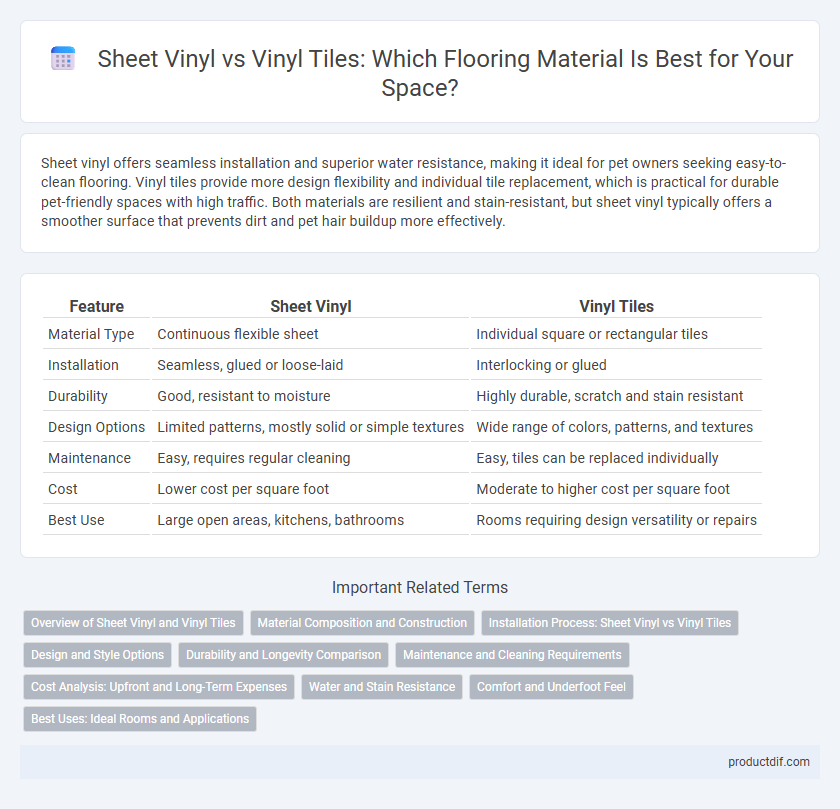Sheet vinyl offers seamless installation and superior water resistance, making it ideal for pet owners seeking easy-to-clean flooring. Vinyl tiles provide more design flexibility and individual tile replacement, which is practical for durable pet-friendly spaces with high traffic. Both materials are resilient and stain-resistant, but sheet vinyl typically offers a smoother surface that prevents dirt and pet hair buildup more effectively.
Table of Comparison
| Feature | Sheet Vinyl | Vinyl Tiles |
|---|---|---|
| Material Type | Continuous flexible sheet | Individual square or rectangular tiles |
| Installation | Seamless, glued or loose-laid | Interlocking or glued |
| Durability | Good, resistant to moisture | Highly durable, scratch and stain resistant |
| Design Options | Limited patterns, mostly solid or simple textures | Wide range of colors, patterns, and textures |
| Maintenance | Easy, requires regular cleaning | Easy, tiles can be replaced individually |
| Cost | Lower cost per square foot | Moderate to higher cost per square foot |
| Best Use | Large open areas, kitchens, bathrooms | Rooms requiring design versatility or repairs |
Overview of Sheet Vinyl and Vinyl Tiles
Sheet vinyl offers a continuous, seamless surface made from flexible synthetic materials, ideal for moisture resistance and easy maintenance in high-traffic areas. Vinyl tiles consist of individual square or rectangular pieces that mimic the appearance of natural materials like wood or stone, providing versatile design options and straightforward installation or replacement. Both flooring types share durability and water resistance but differ in installation methods, aesthetic flexibility, and repair convenience.
Material Composition and Construction
Sheet vinyl flooring consists of a continuous, flexible sheet made primarily from polyvinyl chloride (PVC) combined with plasticizers and stabilizers, offering a seamless surface highly resistant to moisture. Vinyl tiles are composed of layered vinyl planks or tiles with a vinyl top layer and often a fiberglass or limestone core, providing enhanced durability and ease of replacement. The construction differences impact installation, maintenance, and resilience, with sheet vinyl providing uniformity and vinyl tiles offering design versatility.
Installation Process: Sheet Vinyl vs Vinyl Tiles
Sheet vinyl installation involves rolling out a continuous, flexible sheet that requires precise measurements and cutting to fit the space, minimizing seams and creating a waterproof surface ideal for kitchens and bathrooms. Vinyl tiles are individual squares or planks that can be installed using adhesive or a click-lock system, offering easier replacement of damaged sections and allowing for more design versatility. Both options require a clean, smooth subfloor, but sheet vinyl demands more careful handling during installation to avoid wrinkles and bubbles.
Design and Style Options
Sheet vinyl offers continuous, seamless surfaces ideal for large areas with a uniform look, while vinyl tiles provide modular design flexibility allowing for intricate patterns and individual tile customization. Vinyl tiles are available in diverse shapes, colors, and textures, making them suitable for creative layouts and mimicry of natural materials like wood or stone. Sheet vinyl excels in contemporary, minimalist designs, whereas vinyl tiles cater to varied aesthetic preferences with customizable grout lines enhancing patterns.
Durability and Longevity Comparison
Sheet vinyl offers superior durability due to its continuous, seamless surface that resists moisture and wear better than vinyl tiles with seams prone to cracking. Vinyl tiles provide enhanced longevity through easier individual replacement, extending the floor's lifespan without full replacement costs. Both materials maintain resilience under heavy foot traffic, but sheet vinyl generally delivers longer-lasting performance in moisture-prone environments.
Maintenance and Cleaning Requirements
Sheet vinyl flooring offers a seamless surface that minimizes dirt accumulation and simplifies maintenance with quick sweeping and mopping. Vinyl tiles require more attention to grout lines, which can trap dirt and necessitate periodic deep cleaning and sealing. Both materials resist stains and water, but sheet vinyl typically demands less intensive upkeep over time.
Cost Analysis: Upfront and Long-Term Expenses
Sheet vinyl generally offers a lower initial cost compared to vinyl tiles, making it a budget-friendly option for large areas. Vinyl tiles tend to have higher upfront expenses due to individual tile pricing and installation complexity, but their modular nature allows for easier spot repairs, potentially reducing long-term maintenance costs. Over time, the durability and ease of replacement of vinyl tiles can result in cost savings, whereas sheet vinyl may incur higher expenses if large sections need replacement.
Water and Stain Resistance
Sheet vinyl offers superior water resistance due to its seamless installation, preventing moisture from penetrating the flooring, unlike vinyl tiles which have grout lines that can allow water seepage. Stain resistance is enhanced in sheet vinyl because its continuous surface eliminates gaps where spills can accumulate, making cleanup easier compared to vinyl tiles. Both materials feature protective wear layers, but sheet vinyl's monolithic design provides a more effective barrier against water and stains in high-moisture areas like kitchens and bathrooms.
Comfort and Underfoot Feel
Sheet vinyl offers a seamless surface that enhances underfoot comfort by eliminating grout lines, providing a smooth, cushioned feel ideal for prolonged standing. Vinyl tiles, while also soft, may have slight indentations or seams that affect the overall sensation underfoot, potentially reducing comfort. Both materials benefit from added underlayment options to improve cushioning and reduce noise, but sheet vinyl generally delivers a more consistent and plush experience.
Best Uses: Ideal Rooms and Applications
Sheet vinyl offers a seamless surface ideal for moisture-prone areas such as bathrooms and kitchens, providing easy cleaning and water resistance. Vinyl tiles excel in high-traffic spaces like entryways and commercial settings due to their durability and modular repair capabilities. Both flooring options suit diverse applications, but selection depends on room conditions, aesthetic preferences, and maintenance requirements.
Sheet Vinyl vs Vinyl Tiles Infographic

 productdif.com
productdif.com